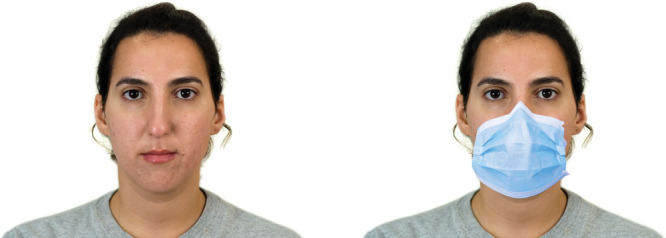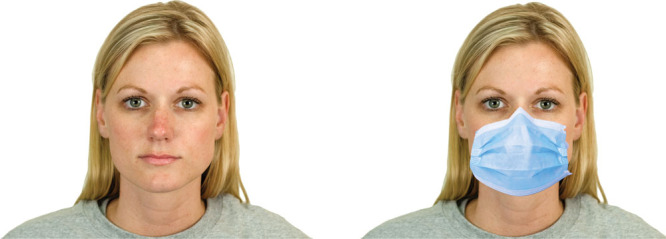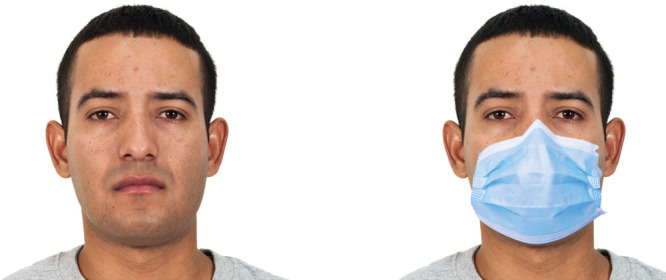INTRODUCTION
Coronavirus disease 2019 has profoundly changed society, culture, commerce, and perhaps most importantly, human interaction. As the citizens of the world followed government-imposed stay-at-home orders, and as the phrase “social distancing” became part of the daily lexicon in a matter of weeks, the public largely adopted the use of face coverings in public places to reduce potential transmission of the virus.
The practice of using face coverings for the nose and mouth, whether with homemade fabrics or with surgical masks, undoubtedly has effects on facial perception. Although emotions such as intense fear can be communicated with contraction of the muscles of the brow and those around the eyes, communication of genuine happiness requires contraction of the muscles around the mouth, which is unlikely to be seen behind a face covering.1 Additionally, the lower half of the face, and specifically the perioral area, has been shown to be vital for determinations of attractiveness. In the 1980s, Dr. Leslie Farkas, widely recognized as the father of craniofacial anthropometry, sought to define the facial measurements and proportions associated with attractive faces.2 When comparing attractive and unattractive faces, Dr. Farkas found that the greatest differences in facial measurements and proportions were centered around the perioral area, including but not limited to a narrow philtrum, a wider oral commissure distance, and a greater protrusion of the upper vermilion.3 With this in mind, it is interesting to consider how masks concealing the lower half of the face would affect perceived attractiveness, which has been shown to influence judgments of a range of interpersonal characteristics, such as competence and trustworthiness.1,4,5
The present study was undertaken to assess whether judgments of attractiveness differ when the lower face is covered by a surgical mask. We anticipated that faces covered with surgical masks would be judged as more attractive than faces not covered by a mask.
METHODS
A racially heterogeneous set of 30 male and 30 female faces was obtained from the Chicago Face Database.6 The Chicago Face Database is a set of high-resolution images of subjects’ faces aged between 18 and 40 years, which is available to researchers as a free resource. The faces were altered to simulate the appearance of wearing a surgical mask, using Microsoft PowerPoint (Microsoft Corporation, Redmond, Wash.) (Figs. 1–3).
Fig. 1.

Photograph of an “unattractive” face (left), with 71% improvement after mask application (right).
Fig. 3.

Photograph of an “attractive” face (left), with 11% improvement after mask application (right).
Fig. 2.

Photograph of an “average” face (left), with 29% improvement after mask application (right).
The photographs of faces were evaluated by users recruited and compensated through Amazon’s Mechanical Turk (MTurk) (Amazon Corp, Seattle, Wash.), a crowdsourcing platform. Samples generated from MTurk have been shown to be of superior quality than that of traditional convenience samples, and MTurk has been used in both the social science and plastic surgery literatures.7–9 Raters were randomly assigned to a set of male or female faces. A series of 60 masked and unmasked faces were then randomly presented, and the raters were asked to rate the attractiveness of each face on a scale of 1 (least attractive) to 10 (most attractive). Raters were excluded from the study based on built-in attention checks and by the minimum time limit for completion to ensure data validity. The study was determined to be exempt from review by the Children’s Hospital of Philadelphia’s Institutional Review Board.
Ratings of unmasked photographs were used to define 3 categories of attractiveness for men and women: “unattractive” (bottom 33%), “average” (33%–66%), and “attractive” (above 66%). The average of an individual face’s unmasked ratings was used to place each face into 1 of these categories. Percent improvement of attractiveness from baseline was calculated for each face after application of the mask, and analysis of normal variance was used to compare this between categories. A post hoc analysis was then conducted using Scheffe pairwise comparisons. Paired t tests were used to determine whether ratings of faces changed significantly after application of a mask. Stata version 14 (College Station, Tex.) was used for data analysis, and standard descriptive statistics were conducted.
RESULTS
A total of 496 raters’ responses were analyzed. There were significant differences in the average percent improvement for faces in the unattractive, average, and attractive cohorts for both women and men (P < 0.001, P < 0.001, respectively) (Table 1). Interestingly, the largest percentage improvements were seen in the unattractive groups, with an approximately 42% increase in ratings for women and men after the application of a mask. Furthermore, in post hoc pairwise comparisons, the unattractive group showed a significantly higher percentage improvement when compared with the average and attractive groups, for both women and men. In contrast, there was no difference in the percentage improvement between the average and the attractive groups, for both genders. When looking at changes in ratings for faces, we found that 100% of the faces in the unattractive group were rated significantly higher after application of a mask, compared with approximately 70% of the average faces, for both women and men. Interestingly, in the attractive group, 1 male face (25%) and 1 female face (12.5%) were rated significantly lower after application of a mask.
Table 1.
Rating Changes after Application of Mask
| Females | Males | |||||||
|---|---|---|---|---|---|---|---|---|
| Unattractive (n = 7) | Average (n = 15) | Attractive (n = 8) | P | Unattractive (n = 5) | Average (n = 20) | Attractive (n = 5) | P | |
| Unmasked rating | 3.20 | 4.68 | 6.21 | <0.0001 | 2.64 | 4.21 | 6.04 | <0.0001 |
| Masked rating | 4.03 | 5.01 | 6.23 | 0.38 | 3.42 | 4.66 | 5.97 | <0.001 |
| Percent improvement | 42.1% | 18.8% | 5.76% | <0.0001 | 42% | 24% | 8.49% | 0.001 |
| Percentage significantly changed | 100% | 73% | 12.5%* | 0.001 | 100% | 75% | 20%* | 0.022 |
Rating significantly decreased with mask.
DISCUSSION
The present study provides novel information about judgments of attractiveness of persons wearing surgical masks. Individuals who were thought to be average or unattractive at baseline were judged as more attractive when wearing masks, which hid their lower face. This effect was the strongest for faces in the lower third strata of attractiveness.
Although the eyes and the periorbital region are often cited as the facial regions that define beauty, the results from the study suggest that other facial features also contribute to judgments of attractiveness, corroborating the long-held ideal that beauty is a result of the harmony of various facial aspects.10,11 Symmetry of facial features across the midline of the face, as well as the “averageness” in size and shape of discrete features, has been shown to be reliable markers of facial attractiveness.12,13 If disharmonious parts, such as the nose, lips, jaw, and neck, are hidden from view, then perceptions of attractiveness increase.
From the perspective of evolutionary biology, symmetry, averageness, and youthfulness of facial features (and bodily features) are markers of physical attractiveness and reproductive potential.12,13 In contrast, individuals who have asymmetrical, nonaverage, or non-youthful features are seen as less attractive. The most profound example of this is seen in persons with facial disfigurement, who are not only seen as less attractive, but also assumed to have less positive personality traits than those who are less or non-disfigured.14 Unfortunately, there is recent evidence to suggest that these responses are truly hardwired into the occipitotemporal cortex and anterior cingulate cortex of the brain.14 It would be interesting to see whether these areas also respond when the lower half of the face is obscured with a face covering or mask.
This study has important implications for medical practice. Communication of the 7 universal face expressions—anger, disgust, fear, surprise, happiness, sadness, and contempt—involves the entire face. If the lower face is obscured by a surgical mask or face covering, there is potential for the misinterpretation of the information being conveyed in a conversation. In clinical practice, both providers and patients wearing face coverings or masks run the risk of being misunderstood or misunderstanding one another. As we move to a return to normalcy in health care, as well as daily life, we may wish to consider that the physical distancing that has come with the delivery of health care via electronic platforms may enhance patient–provider communication beyond what can occur in person but with faces partially covered by masks.
The results of this study also have important implications for society. First, with facial cues being limited, it is interesting to consider where the gaze will turn to make these judgments of attractiveness. Will there be increased emphasis on the orbital complex and the upper face or will the gaze then turn to other body parts like the torso? If the practice of wearing masks endures, it would not be surprising for plastic surgeons to see a rise in patients seeking alterations to the body parts that are still visible, as these will be the only ways to express one’s attractiveness. Conversely, will the use of fillers and neuromodulators in and around the perioral region decline in popularity, and will surgical procedures such as rhytidectomy and genioplasty be sought less frequently? What will happen to the sales of lipstick and tooth whiteners as well as other applied enhancers and cosmetics? Additionally, the mask itself could affect perceptions of an individual’s attractiveness. Will certain colors, patterns, and designs of masks be viewed as more acceptable than others and will we move to the development of a “see-through” mask that allows some emotions visually based in the perioral region to be expressed? The results of this study bring all these questions to the forefront. Regardless, it is clear that there are far greater implications for this practice than meets the eye.
ACKNOWLEDGMENT
This study was granted an exemption by the Institutional Review Board at the Children’s Hospital of Philadelphia.
PATIENT CONSENT
Patients provided written consent for the use of their images.
Footnotes
Published online 20 August 2020.
Disclosure: Dr. Sarwer currently has grant funding from the National Institutes of Health [National Institute for Diabetes, Digestive, and Kidney Disease (R01 DK108628) and the National Institute for Dental and Craniofacial Research (R01DE026603)] and the Department of Defense. He also has consulting relationships with Ethicon, Merz, and Novo Nordisk. He currently is on the Board of Directors of the Aesthetic Society Research and Education Foundation and is a Consulting Editor for Plastic and Reconstructive Surgery. All the other authors have no financial interest to declare.
REFERENCES
- 1.Ekman P. Universal and cultural differences in facial expressions of emotions. In: Nebraska Symposium on Motivation. 1972:Lincoln, NE: University of Nebraska Press; 207–282. [Google Scholar]
- 2.Naini FB. Leslie G. Farkas, 1915–2008. Am J Orthod Dentofacial Orthop. 2009;136:614. [Google Scholar]
- 3.Munro IR, Farkas LG. Anthropometric Facial Proportions in Medicine. 1987New York: Thomas; [Google Scholar]
- 4.Jamrozik A, Ali MO, Sarwer DB, et al. More than skin deep: judgments of individual with facial disfigurement. Psychol Aesthet Creat Arts. 2019;13:117–129. [Google Scholar]
- 5.Maestripieri D, Henry A, Nickels N. Explaining financial and prosocial biases in favor of attractive people: interdisciplinary perspectives from economics, social psychology, and evolutionary psychology. Behav Brain Sci. 2017;40:e19. [DOI] [PubMed] [Google Scholar]
- 6.Ma DS, Correll J, Wittenbrink B. The Chicago face database: a free stimulus set of faces and norming data. Behav Res Methods. 2015;47:1122–1135. [DOI] [PubMed] [Google Scholar]
- 7.Berinsky AJ, Huber GA, Lenz GS. Evaluating online labor markets experimental research: Amazon.com’s Mechanical Turk. Polit Anal. 2012;20:351–368. [Google Scholar]
- 8.Patel V, Mazzaferro DM, Swanson JW, et al. Public perception of helical rim deformities and their correction with ear molding. J Craniofac Surg. 2020;31:741–745. [DOI] [PubMed] [Google Scholar]
- 9.Mazzaferro DM, Wes AM, Naran S, et al. Orthognathic surgery has a significant effect on perceived personality traits and emotional expressions. Plast Reconstr Surg. 2017;140:971–981. [DOI] [PubMed] [Google Scholar]
- 10.Bueller H. Ideal facial relationships and goals. Facial Plast Surg. 2018;34:458–465. [DOI] [PubMed] [Google Scholar]
- 11.Saegusa C, Watanabe K. Judgments of facial attractiveness as a combination of facial parts information over time: social and aesthetic factors. J Exp Psychol Hum Percept Perform. 2016;42:173–179. [DOI] [PubMed] [Google Scholar]
- 12.Sarwer DB. Body image, cosmetic surgery, and minimally invasive treatments. Body Image. 2019;31:302–308. [DOI] [PubMed] [Google Scholar]
- 13.Sarwer DB, Spitzer JC. Psychology of facial aesthetics. In: Aesthetic Surgery of the Facial Skeleton. Philadelphia, Pa.: Elsevier; In press. [Google Scholar]
- 14.Hartung F, Jamrozik A, Rosen ME, et al. Behavioural and neural responses to facial disfigurement. Sci Rep. 2019;9:8021. [DOI] [PMC free article] [PubMed] [Google Scholar]


